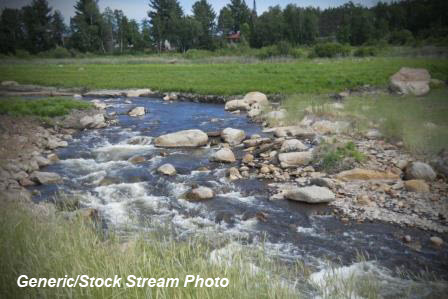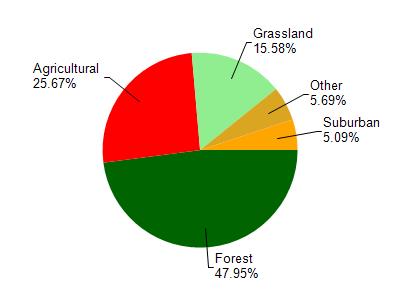
5.69 Miles
0 - 5.69
Cool-Cold Mainstem, Cool-Cold Headwater
2022
Good
Monroe
Yes
Yes
No
Fish and Aquatic Life
Overview
Lyons Valley Creek, also known as Creek 29-9, is a small spring-fed stream located in southwestern Monroe County. It flows in a westerly direction for five miles before reaching the Little La Crosse River north of Melvina. It has a gradient of 76 feet per mile and drains forested hills and agricultural valley land. Lyons Valley Creek is a Class I trout stream for its entire length.
The most recent survey, completed in 1974, documented a stream bottom comprised predominately of rubble with lesser amounts of sand, silt, and gravel. Riparian land consisted mainly of upland hardwoods with lesser amounts of cultivated fields and pasture. Undercut banks provided most of the in-stream cover for fish, with pools, logs, and aquatic vegetation present, but generally scarce. Brown trout and several forage fish species were found. The Lyons Valley Creek fishery would benefit from additional in-stream habitat. A fish and habitat survey should be conducted of Lyons Valley Creek to document the current status of the stream. There are no DNR stocking records for this stream. Access is possible from two road crossings and DNR owned easements.
Date 2002
Author Aquatic Biologist
Condition
Wisconsin has over 84,000 miles of streams, 15,000 lakes and milllions of acres of wetlands. Assessing the condition of this vast amount of water is challenging. The state's water monitoring program uses a media-based, cross-program approach to analyze water condition. An updated monitoring strategy (2015-2020) is now available. Compliance with Clean Water Act fishable, swimmable standards are located in the Executive Summary of Water Condition in 2018. See also the 'monitoring and projects' tab.
Reports
Management Goals
Wisconsin's Water Quality Standards provide qualitative and quantitative goals for waters that are protective of Fishable, Swimmable conditions [Learn more]. Waters that do not meet water quality standards are considered impaired and restoration actions are planned and carried out until the water is once again fishable and swimmable
Management goals can include creation or implementation of a Total Maximum Daily Load analysis, a Nine Key Element Plan, or other restoration work, education and outreach and more. If specific recommendations exist for this water, they will be displayed below online.
Monitoring
Monitoring the condition of a river, stream, or lake includes gathering physical, chemical, biological, and habitat data. Comprehensive studies often gather all these parameters in great detail, while lighter assessment events will involve sampling physical, chemical and biological data such as macroinvertebrates. Aquatic macroinvertebrates and fish communities integrate watershed or catchment condition, providing great insight into overall ecosystem health. Chemical and habitat parameters tell researchers more about human induced problems including contaminated runoff, point source dischargers, or habitat issues that foster or limit the potential of aquatic communities to thrive in a given area. Wisconsin's Water Monitoring Strategy was recenty updated.
Grants and Management Projects
| Project Name (Click for Details) | Year Started |
|---|
|
|
Monitoring Projects
| WBIC | Official Waterbody Name | Station ID | Station Name | Earliest Fieldwork Date | Latest Fieldwork Date | View Station | View Data |
|---|
| 1656900 | Unnamed | 10015605 | Cr. 29-9 (Lyon Valley Cr.) St. 13 - Lamplighter Rd. Bridge Crossing | 1/1/2015 | 8/29/2022 | Map | Data |
| 1656900 | Unnamed | 10015537 | Cr. 29-9 (Lyon Valley) St. 1 - Cth Xx Bridge Crossing | | | Map | Data |
| 1656900 | Unnamed | 10015607 | Cr. 29-9 (Lyon Valley Cr.) St. 2 - 300ft Upsteam And Downstream Of Mouth Of Cr. 27-7 | | | Map | Data |
| 1656900 | Unnamed | 10015606 | Cr. 29-9 (Lyon Valley Cr.) St. 14 - Farm Rd. Bridge Crossing In Ne 1/4 S28 | | | Map | Data |
| 1656900 | Unnamed | 10032331 | Unnamed Creek (1656900) -100m US of Cr. 27-13 (Kowitz easement) | | | Map | Data |
|

Watershed Characteristics
Unnamed is located in the Little La Crosse River watershed which is 240.79 mi². Land use in the watershed is primarily forest (48%), agricultural (25.70%) and a mix of grassland (15.60%) and other uses (10.80%). This watershed has 445.88 stream miles, 114.59 lake acres and 5,439.88 wetland acres.
Nonpoint Source Characteristics
This watershed is ranked High for runoff impacts on streams, Not Ranked for runoff impacts on lakes and Low for runoff impacts on groundwater and therefore has an overall rank of Low. This value can be used in ranking the watershed or individual waterbodies for grant funding under state and county programs.However, all waters are affected by diffuse pollutant sources regardless of initial water quality. Applications for specific runoff projects under state or county grant programs may be pursued. For more information, go to surface water program grants.
Lyon Valley Creek (T16n R3w S29)(Creek 29-9) is considered a Cool-Cold Mainstem, Cool-Cold Headwater under the state's Natural Community Determinations.
Natural communities (stream and lake natural communities) represent model results and DNR staff valiation processes that confirm or update predicted conditions based on flow and temperature modeling from historic and current landscape features and related variables. Predicated flow and temperatures for waters are associated predicated fish assemblages (communities). Biologists evaluate the model results against current survey data to determine if the modeled results are corect and whether biological indicators show water quaity degradation. This analysis is a core component of the state's resource management framework. Wisconsin's Riverine Natural Communities.
Cool (Cold-Transition) Mainstem streams are moderate-to-large but still wadeable perennial streams with cold to cool summer temperatures. Coldwater fishes are common to uncommon, transitional fishes are abundant to common, and warm water fishes are uncommon to absent. Headwater species are common to absent,
mainstem species are abundant to common, and river species are common to absent.
Cool (Cold-Transition) Headwaters are small, usually perennial streams with cold to cool summer temperatures. Coldwater fishes are common to uncommon (<10 per 100 m), transitional fishes are abundant to common, and warm water fishes are uncommon to absent. Headwater species are abundant to common, mainstem species are common to absent, and river species are absent.